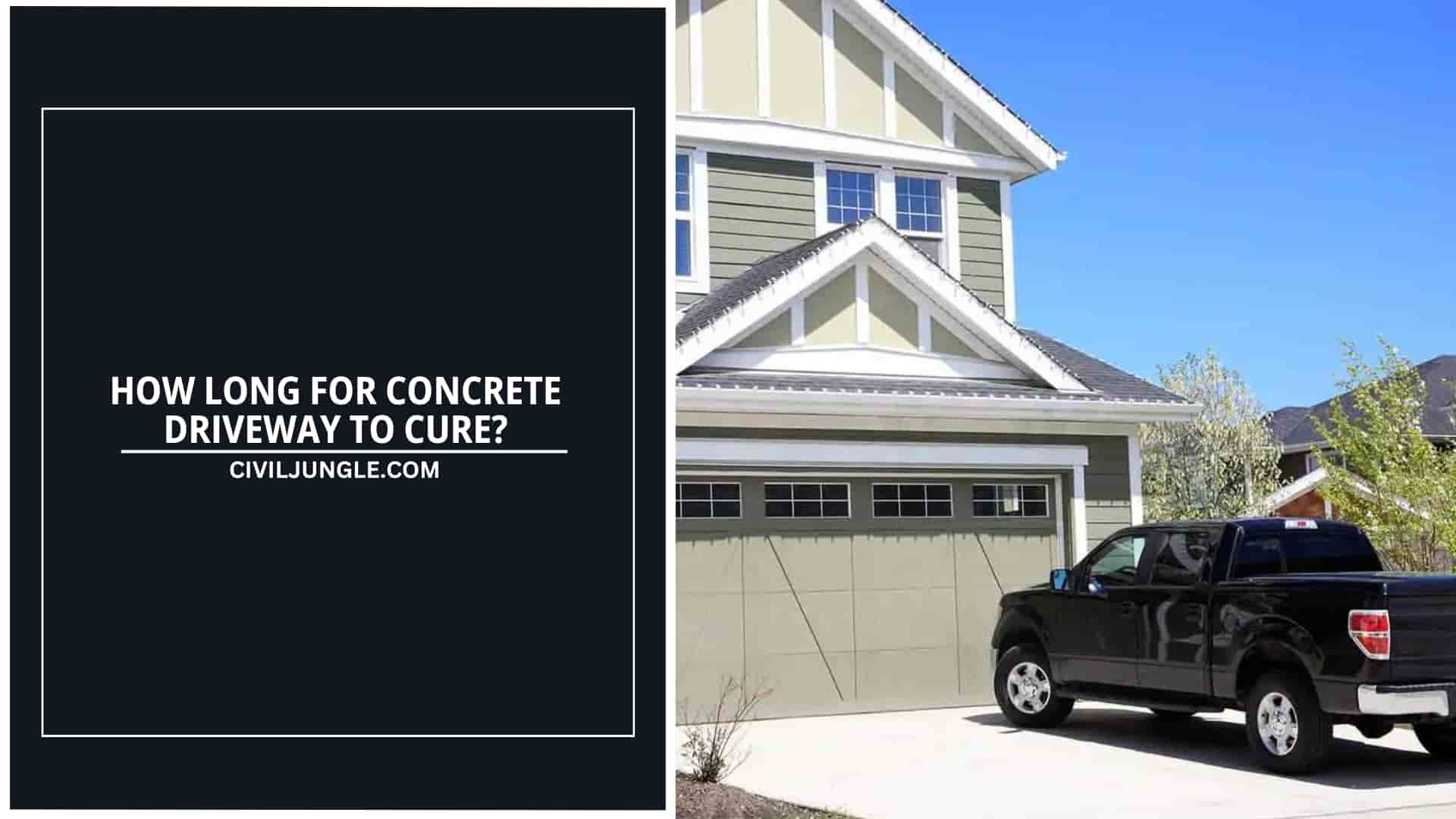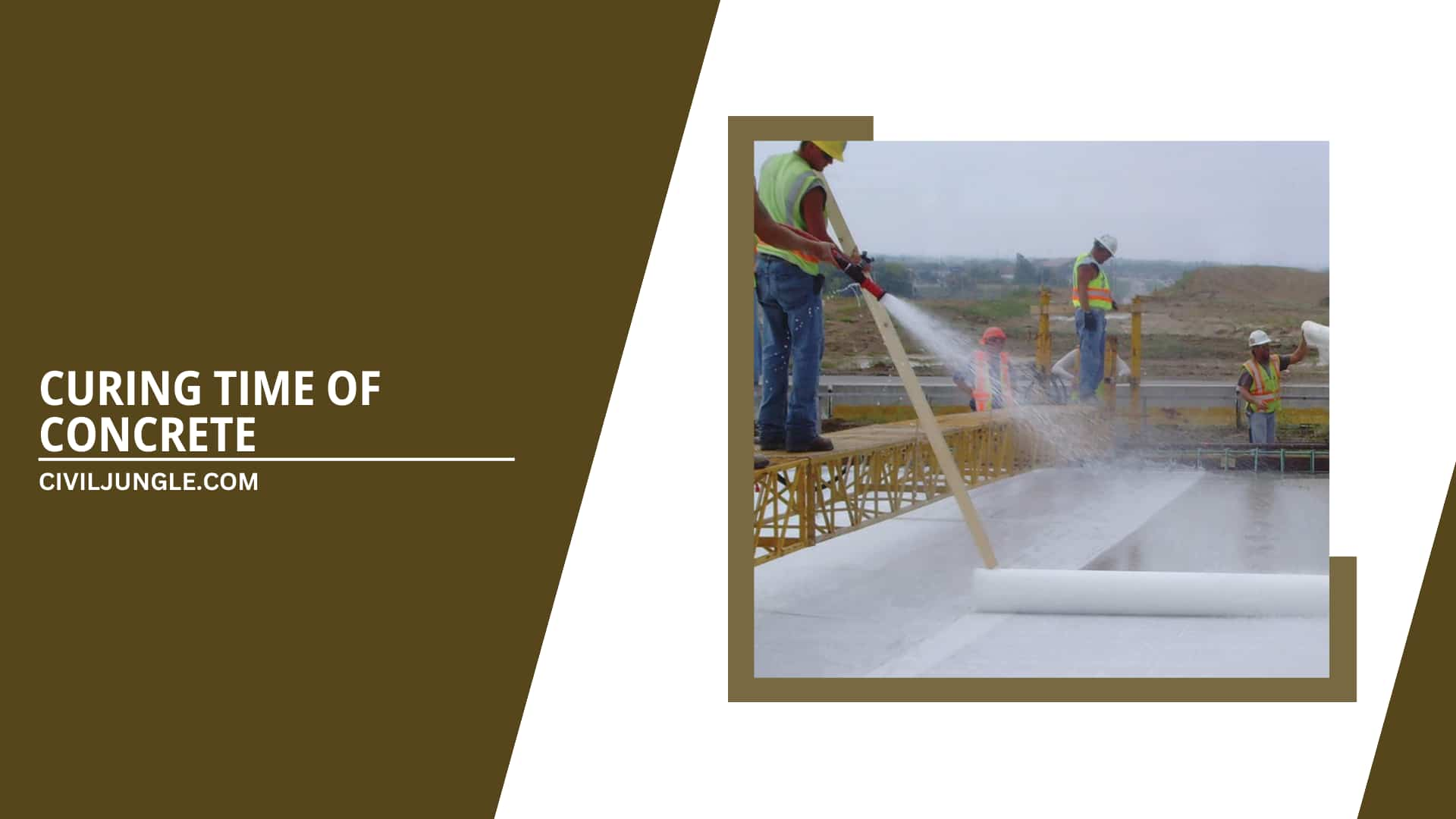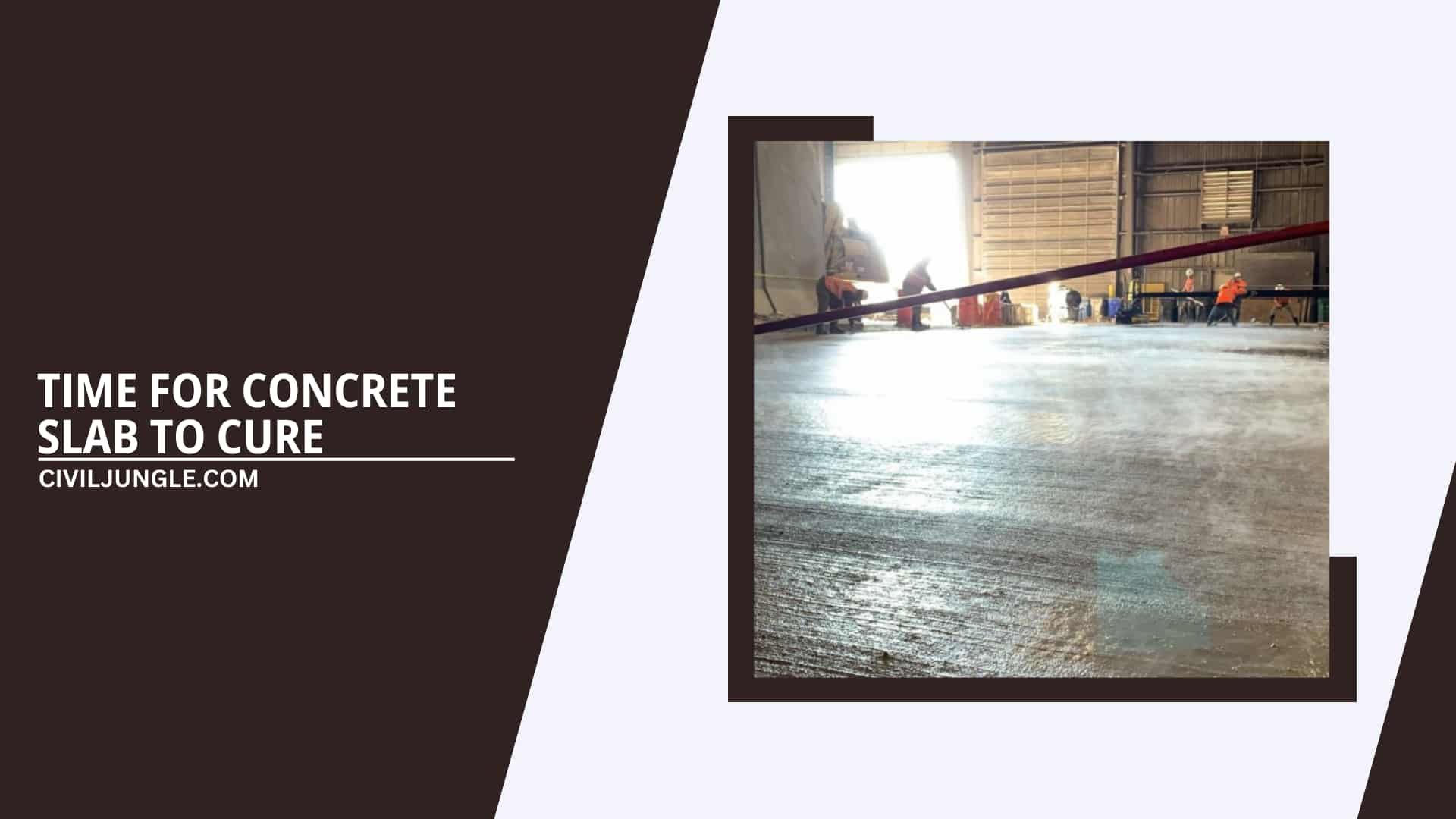
It takes 24 to 48 hours to dry enough to walk on.
However, concrete drying is a continuous and fluid phenomenon and reaches its full adequate strength after about 28 days.
This gives the material time to become as strong as possible.
While you can open freshly cemented areas to light foot traffic after a day or two and standard-size vehicles after a week, allow the concrete to cure for 28 days before you allow any heavy machinery or other large objects onto the surface.
Curing is responsible for concrete slabs’ durability, stability, and strength.
It refers to providing concrete with the current moisture, time, and temperature to develop the desired properties.
It takes about a month to harden fully, but your concrete will soon be ready to use.
Each project will be slightly different due to differences in weather, concrete mix, and placement and finishing techniques.
Most concrete, primarily decorative concrete, will initially contain too much water in the mix to hydrate the cement fully.
If the exposed surfaces are dry, the concrete cannot hydrate, and our young concrete quickly ends up with sensitive skin and is sometimes really dusty.
There are three ways to cure concrete: pour water on the surface to replace the water that evaporates, seal the concrete to prevent water from evaporating, or do both.
And adding water to the surface doesn’t mean adding water that will work into the concrete mix—it will increase and weaken the water-cement ratio of the surface concrete, ruining all our curing efforts.
There are three stages of treatment, and the length of time for each depends on concrete and environmental conditions.
The bleed water increases as the concrete mixture solidifies when the concrete is placed on the slab.
During this initial set period, if the bleeding water evaporates from the surface faster than it can escape from the concrete, you need to do some preliminary treatment. Otherwise, you are likely to end up with plastic shrinkage cracks.
To know if this is necessary, look at the evaporation rate.
Intermediate curing is required when finishing or stamping is completed before the final step between the initial and final sets.
After the last set, you must do the final treatment.
A concrete curing blanket is an effective option that cures concrete 2.8 times faster than a generally insulated blanket and properly maintains moisture throughout the hydrating process.
And the concrete blankets are easily transported, installed, and maintain ACI compliance for cold-weather concreting.
If you are looking for a solution to support optimum substantial cure time during cold winter, using a concrete blanket is the best method for drying and curing concrete.
Also Read: What Is Sheepsfoot Roller?
Curing Time of Concrete

Technically, concrete never stops healing.
Concrete gets more robust as time goes on.
But, as far as we are concerned, most industrial concrete mixes have a 28-day curing period to gain usable power to reach a practical strength.
Ultimate curing takes several weeks, and strength tests for concrete are performed after 28 days.
Curing time compounds itself, meaning time can double and triple exponentially.
The industrial rule-of-thumb for estimating curing time is one month of drying for every inch of the concrete.
Thus a 7-inch slab of newly poured concrete would take seven months to cure fully.
Temperature and humidity play a part in this process as well.
Ready mix operators add these chemicals during the mixing process according to the instructions from the contractor.
Also Read: Two Tone Kitchen Cabinets
Time for Concrete to Cure Before Rain
If rain is in the forecast for the days or hours after you expect to finish the job, you should not have to worry.
As long as the concrete is given 4 to 8 hours after mixing and finishing to set up, rainwater won’t affect it nearly as badly as it could.
The concrete mixture can often displace the rainwater, pushing it upwards and out of the cavity into rainwater pools.
The biggest problem you faced was the effect the rein may have had on the surface of the concrete.
If it was not covered before the onset of the rain, if the hardening was not very far along by that time, and if there was enough rain falling with enough force, the rein may have washed some of the cement out of the concrete.
Rain can contaminate fresh and wet concrete mixes. Pinning concrete during rain storms will cause various problems due to exposure to and exposure to rainwater.
Useful Article for You
- How Much Does a Yard of Concrete Weigh
- How Tall Is a Door
- How Many Stairs in a Flight
- How Many Bags of Concrete in a Yard
- How to Get Burnt Smell Out of Microwave
- How Far Apart Should Fence Posts Be
- How Are Bridges Built Over Water
- How Many People Died Building the Great Wall of China
- How to Draw House
- How to Build a Lean to Roof
- How Many Bags of Concrete for 1 Yard
- How Much Does Cinder Block Cost
- How to Get a House for Free
- Does Concrete Have Lime in It
- How Much Does It Cost to Soundproof a Room
- How to Read a Measuring Tape in Meters
- How to Mount a TV on a Brick Wall
- How to Use Washers
- How to Get Property for Free
- How Much Does a Gallon of Water Weight?
- How Many Tiles Do I Need?
- How Much Does It Cost to Build a Pergola?
- How Much Does a Concrete Slab Cost?
- How Much Does a Yard of Gravel Weigh?
- How Many Shingles Do I Need for a 24×24 Garage?
- How to Remove Paint from Concrete Without Chemicals
- How to Cover Concrete Walls in Basement
- How to Find Wall Load
- How to Build a Cavity Wall
- How Much Does a Heated Driveway Cost
- How Much Spray Foam Do I Need
- How to Get Blood Out of Carpet
- How to Find the Contour Interval
- How to Identify Zero Force Members
- How To Install A Welded Wire Fence
- How to Tell If a Wall Is Load Bearing
- How to Replace Outdoor Faucet
- How to Tell the Difference Between Marble and Granite
- How to Get Free Wood Pallets
- How Long Should Concrete Forms Stay On
- How Much Does an 8x8x16 Concrete Block Weight
- How to Extend Vinyl Fence Height
- How to Calculate Water Cement Ratio
- How to Calculate Cement Quantity
Time for Concrete to Cure Before Building
The answer is that your concrete will be set up surprisingly quickly.
Your concrete should be strong enough to walk on without leaving footprints after 24 to 48 hours.
Curing cement controls the rate and extent of moisture loss from concrete during hydration.
Concrete drying time before construction is between 24 and 48 hours after placing concrete.
Concrete usually takes 24 to 48 hours to dry.
However, substantial drying is a continuous and fluid phenomenon and usually reaches its full adequate strength after about 28 days.
Your concrete should be at least 70 percent cured within seven days.
To get the most robust finish from your new concrete slab for years to come, we recommend using it at least seven days after it has been properly installed.
The concrete mixture can often displace the rainwater, pushing it upward and out of the cavity into the rainwater, moving it upward and out of the hole into rainwater pools.
Also Read: How Many Bags of Concrete in a Yard?
Time for Concrete to Cure in Cold Weather

Concrete drying time at a specific curing temperature.
A well-graded concrete mix should achieve this strength within 24 to 48 hours.
Therefore, newly placed concrete should be protected from freezing for the first 24 to 48 hours or until the concrete has attained a strength of approximately 500 psi.
Special planning is required for concreting in cold weather.
To obtain a durable concrete product in cold weather, special care must be taken in aggregate production, proper mix design, adequate mixing and transportation, proper placement and finishing methods, and safety.
Concrete is placed, prepared, and cured to its true strength in cold weather if adequate planning and care are taken.
Curing concrete in cold weather becomes more challenging because to set and reach maximum power properly, fresh concrete must be allowed to rest for at least the first 24 hours or at least 500 pounds per square inch (psi).
It must be old. It is protected from cold.
Concrete can be placed, prepared, and cured successfully in cold weather or during winter, but the effect of cold weather on the long-term concrete production process needs to be understood.
How Long for Concrete Driveway to Cure?
Concrete usually takes 24 to 48 hours before you can walk or drive on it.
However, significant drying is a continuous and fluid phenomenon and reaches its full significant strength after about 28 days.
Here are some basic facts about concrete drying and curing times.
The curing process is just as important as the installation of a concrete driveway or sidewalk.
Driving or parking heavy equipment or machinery over your newly poured concrete will take extra time, so allow at least 30 days.
The curing time of a concrete driveway should be between 24 and 48 hours after placing the concrete or initial set.
Concrete driveways are usually allowed to dry for 24 to 48 hours.
However, adequate driveway drying is a continuous and fluid phenomenon and usually reaches its full strength after about 28 days.
Also Read: How Many Cubic Feet in a Bag of Concrete?
Time for Concrete Slab to Cure

The vapor barrier or retarder in the assembly is one of the most critical factors controlling slab moisture.
The curing time for concrete slabs shall be at least seven days after the concrete is poured or at least seven days after the initial set.
To get the most robust finish from your new concrete slab for years to come, we recommend taking the time to properly cure your new slab for at least seven days after installation.
Twenty-eight days are ideal. Concrete slabs are one of the two primary foundation sources for homes around the United States, especially in areas where subflooring is impossible.
Time for Concrete Footings to Cure
If possible, excavate and pour all footings and piers simultaneously.
Have rebar and anchor bolts or post bases on hand, as you must add them to the concrete while it is still wet.
You are laying footing.
Concrete foundations should be cured for at least seven days after pouring the concrete or initial set.
Concrete needs 30 days to achieve full strength but 65% in 7 days.
If filling around the edge of the slab is specified, you can carefully do it the day after pouring.
The distance between foundations for support posts is determined by post placement, a factor of beam spans.
Useful Article for You
- Best Light Color for Sleep
- Best Kitchen Sink Material
- Best Architecture Schools in the Us
- Best Concrete Resurfacer
- Best Color Shutters for Cream House
- Best Free Landscape Design Software
- Best Vinyl Siding Colors
- Best Way to Kill Tree Stumps
- Best Way to Drill into Concrete
- Best Shower Pan Material
- Best Type Kitchen Sink
- Best Drywall for Bathroom
- Best Brick Sealer
- Best Caulk for Concrete Cracks
- Best Concrete Patching Compound for Large Cracks
- Best Flooring for Screened Porch
- Why Is 37 Degrees the Best Angle for Stairs
- Best Kinds of Mattresses
- Best Plywood
- Best Roof Ventilation Methods
- Best Color Shingles for Red Brick House
- Who Is the Best Roofing Company
- Best Tile Brands
- What Is the Best Cleaner for Corian Countertops
- Best Trucks for Construction
- Best Finish for Interior Walls
- Best Way to Clean Puke Out of Carpet
- Best Closet Doors
- Best Green Exterior Paint Colors
- Best Acid Stain for Concrete
- Best House Material
- Best Pipe for Plumbing
- Best Admixture for Concrete
Time Needed for Concrete to Cure

24 to 48 hours after the initial set concrete placement or for the concrete to cure.
Concrete usually takes 24 to 48 hours to dry.
However, significant drying is a continuous and fluid phenomenon and usually reaches its full adequate strength after about 28 days.
However, concrete drying is a constant and fluid phenomenon and usually attains sufficient full power after about 28 days.
Here are some basic facts about good drying and curing times.
Also Read: What Is Waterlogging?
Time for Sidewalk Concrete to Cure
The curing time for sidewalk concrete should be 24 to 48 hours after the concrete is placed or initially set.
Concrete sidewalks are usually allowed to dry for 24 to 48 hours before walking or driving.
By the seventh day of curing, your concrete should have cured at least 70 percent of its full power.
You can go over it without damaging it, although you’ll want to prevent heavy rolling equipment.
You can fully harden your in 28 days, your concrete.
However, significant sidewalk drying is a continuous and fluid phenomenon and typically reaches its full adequate strength after about 28 days.
How Long for Concrete Driveway to Cure?
24 to 48 hours
Concrete typically takes 24 to 48 hours to dry enough for you to walk or drive on it. However, concrete drying is a continuous and fluid event and usually reaches its full effective strength after about 28 days.
Time for Concrete Slab to Cure
In general, concrete takes about 28 days to fully cure to its maximum strength. However, the slab can usually be walked on after about 24-48 hours, and light loads can be placed on it after about 7 days. It is important to note that during the first 7 days of curing, the concrete is still quite fragile and can be easily damaged by heavy loads or excessive stress.
How Long Does Concrete Take to Dry?
The drying time of concrete depends on various factors, including the type of concrete, the thickness of the slab, and the ambient conditions. It is important to note that drying and curing are two different processes. Drying refers to the evaporation of excess water in the concrete mixture, while curing refers to the chemical reaction that hardens and strengthens the concrete.
How Long Does Concrete Take to Cure?
The curing time for concrete refers to the period during which it gains strength and durability. The curing time depends on various factors such as the type of cement used, the thickness of the slab, temperature, and humidity levels.
How Long Does It Take for Cement to Cure?
Cement and concrete are often used interchangeably, but they are not the same thing. Cement is an ingredient in concrete, and it is a powder that is mixed with sand, gravel, and water to create the solid material known as concrete.
What Are the Three Methods of Curing Concrete?
The three methods of curing concrete are adding water to the surface, sealing the concrete, or a combination of both.
How Does Rain Affect Curing Concrete?
Rain shortly after pouring and finishing concrete isn’t a big concern if the concrete has had 4 to 8 hours to set up. Rainwater might displace some concrete components but usually doesn’t severely impact it.
How Long Should Concrete Cure Before Construction?
Concrete should be strong enough to walk on without leaving footprints after 24 to 48 hours. To achieve the most robust finish, it’s recommended to wait at least seven days.
Can Concrete Be Cured in Cold Weather?
Yes, concrete can be cured in cold weather, but precautions are necessary to ensure proper strength development. Concrete should be protected from freezing for the first 24 to 48 hours.
How Long Does It Take for a Concrete Driveway to Cure?
Concrete driveways usually take 24 to 48 hours to dry enough for walking or driving. However, full adequate strength is usually reached after about 28 days.
How Long Does It Take for a Concrete Slab to Cure?
Concrete slabs should be cured for at least seven days after pouring to achieve the most robust finish.
What Is the Role of a Vapor Barrier in Curing Concrete Slabs?
A vapor barrier is crucial in controlling slab moisture during the curing process for concrete slabs.
Like this post? Share it with your friends!
Suggested Read –

